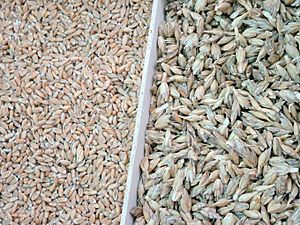Spelt facts for kids
Quick facts for kids Spelt |
|
|---|---|
 |
|
| Scientific classification | |
| Genus: |
Triticum
|
| Species: |
spelta
|
| Synonyms | |
|
|
Spelt (Triticum spelta; Triticum dicoccum), also known as dinkel wheat or hulled wheat, is a species of wheat cultivated since approximately 5000 BCE.
Spelt was an important staple in parts of Europe from the Bronze Age to medieval times; it now survives as a relict crop in Central Europe and northern Spain, and has also found a new market as a 'health food'. Spelt is sometimes considered a subspecies of the closely related species common wheat (Triticum aestivum), in which case its botanical name is considered to be Triticum aestivum subsp. spelta. It is a hexaploid wheat, which means it has six sets of chromosomes.

Contents
Evolution
Spelt has a complex history. It is a wheat species known from genetic evidence to have originated as a naturally occurring hybrid of a domesticated tetraploid wheat such as emmer wheat and the wild goat-grass Aegilops tauschii. This hybridisation must have taken place in the Near East because this is where Aegilops tauschii grows, and it must have taken place before the appearance of common or bread wheat (Triticum aestivum, a hexaploid free-threshing derivative of spelt) in the archaeological record about 8,000 years ago.
Genetic evidence shows that spelt wheat can also arise as the result of hybridisation of bread wheat and emmer wheat, although only at some date following the initial Aegilops–tetraploid wheat hybridisation. The much later appearance of spelt in Europe might thus be the result of a later, second, hybridisation between emmer and bread wheat. Recent DNA evidence supports an independent origin for European spelt through this hybridisation. Whether spelt has two separate origins in Asia and Europe, or single origin in the Near East, is currently unresolved.
History
In Greek mythology spelt (ζειά [zeiá] in Greek) was a gift to the Greeks from the goddess Demeter. The earliest archaeological evidence of spelt is from the fifth millennium BC in Transcaucasia, north-east of the Black Sea, though the most abundant and best-documented archaeological evidence of spelt is in Europe. Remains of spelt have been found in some later Neolithic sites (2500–1700 BC) in Central Europe. During the Bronze Age, spelt spread widely in central Europe. In the Iron Age (750–15 BC), spelt became a principal wheat species in southern Germany and Switzerland, and by 500 BC, it was in common use in southern Britain.
References to the cultivation of spelt wheat in Biblical times (see matzo), in ancient Egypt and Mesopotamia and in ancient Greece are incorrect and result from confusion with emmer wheat.
In the Middle Ages, spelt was cultivated in parts of Switzerland, Tyrol, Germany, northern France and the southern Netherlands. Spelt became a major crop in Europe in the 9th century CE, possibly because it is husked, unlike other grains, and therefore more adaptable to cold climates and is more suitable for storage.
Spelt was introduced to the United States in the 1890s. In the 20th century, spelt was replaced by bread wheat in almost all areas where it was still grown. The organic farming movement revived its popularity somewhat toward the end of the century, as spelt requires less fertilizer. Since the beginning of the 21st century, spelt became a common wheat substitute for making artisanal breads, pastas, and flakes.
People with celiac disease should avoid eating spelt.
Images for kids
-
Wholegrain spelt bread from Poland
See also
 In Spanish: Triticum spelta para niños
In Spanish: Triticum spelta para niños


